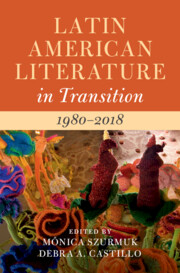Book contents
- Latin American Literature in Transition 1980–2018
- Latin American Literature in Transition
- Latin American Literature in Transition 1980–2018
- Copyright page
- Contents
- Contributors
- Acknowledgments
- Introduction
- Part I Security
- Part II New Genres
- Chapter 5 Speculative Fiction
- Chapter 6 Latin American Digital Literature
- Chapter 7 Children’s Literature in Latin America from School to Marketplace and Beyond
- Chapter 8 Paraliterature
- Chapter 9 Performance Studies
- Chapter 10 Graphing a Hemispheric History of Latinx Comics Creation
- Chapter 11 New Poetry, Fresh Approaches
- Part III Mobilities
- Part IV Positionalities
- Part V Latin American Literature in Global Markets
- Index
- References
Chapter 10 - Graphing a Hemispheric History of Latinx Comics Creation
from Part II - New Genres
Published online by Cambridge University Press: 24 November 2022
- Latin American Literature in Transition 1980–2018
- Latin American Literature in Transition
- Latin American Literature in Transition 1980–2018
- Copyright page
- Contents
- Contributors
- Acknowledgments
- Introduction
- Part I Security
- Part II New Genres
- Chapter 5 Speculative Fiction
- Chapter 6 Latin American Digital Literature
- Chapter 7 Children’s Literature in Latin America from School to Marketplace and Beyond
- Chapter 8 Paraliterature
- Chapter 9 Performance Studies
- Chapter 10 Graphing a Hemispheric History of Latinx Comics Creation
- Chapter 11 New Poetry, Fresh Approaches
- Part III Mobilities
- Part IV Positionalities
- Part V Latin American Literature in Global Markets
- Index
- References
Summary
The chapter considers: (1) the importance of historical period as well as social and political contexts in the making, distribution, and consuming of comics by and about Latinx subjects and experiences of the hemispheric Americas; (2) the specific techniques (panel layout, perspective, coloring, bubble placement, font, and so on) used by Latinx comic book creators to give shape to the everyday lives, unique traditions, and representations of the very varied ethnoracial make-up of Latinx subjects within specifics of times and regions; (3) the construction of Latinx reader-viewers as co-creators of Latinx hemispheric visual-verbal narratives; (4) how these Latinx comics work within and radically resist mainstream comics; and (5) how Latinx comics can and do complicate, enrich, and make new reader-viewers’ perspective, thought, and feeling concerning the experiences Latinx subjects and experiences hailing from the hemispheric Americas. This chapter will provide readers with an analysis of the history of Latinx comics built out of Latin/x hemispheric idiomatic and shared visual and verbal narrative systems. It will provide a history of Latinx hemispheric cross-pollination that includes the physical transmigration of artists and their styles and worldviews from one place (region or country) to another. It will provide a critical history that understands Latin/x comics to be built out of the active participation of entities (creators and editors and translators) in the publishing and translating of comic books across Latin/x hemispheric time (history) and contexts (languages and cultures).
Keywords
- Type
- Chapter
- Information
- Latin American Literature in Transition 1980–2018 , pp. 155 - 165Publisher: Cambridge University PressPrint publication year: 2022

